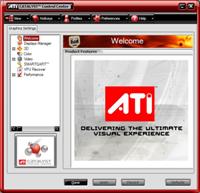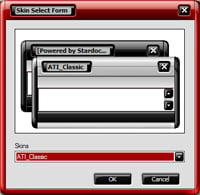ATI's Catalyst Control Center
Introduction
 A tarnished reputation is often the hardest thing to overcome in any business. It is much easier for a company to earn a bad reputation than it is to gain the consumer's faith in any given product. Over the years, ATi struggled to overcome a reputation for having sub-par drivers. This impression seemed to grab hold and not let go for many years, although the company continued to improve their drivers regularly.
A tarnished reputation is often the hardest thing to overcome in any business. It is much easier for a company to earn a bad reputation than it is to gain the consumer's faith in any given product. Over the years, ATi struggled to overcome a reputation for having sub-par drivers. This impression seemed to grab hold and not let go for many years, although the company continued to improve their drivers regularly.
The biggest step ATi took to correct the situation was to essentially overhaul their driver development process, which resulted in the introduction of the Catalyst driver package in June 2002. This was a major step forward in addressing a number of issues, with the goal of providing frequent updates and a more stable driver suite. Since then, the Catalysts have been the backbone of ATi's graphics cards, offering a broad collection of features to enhance the end-user's experience and strengthen the performance and stability of their graphics cards.
Since their initial release, ATi's Catalysts have evolved quite a bit and the overall impression is that they were a success. While we can't outright say that ATi has erased its reputation of having occasionally less than stable drivers, the situation has arguably improved tremendously.
Today, ATi is aiming to add another layer to the Catalyst software package in an effort to bring new features, added stability and a streamlined interface to the game with the introduction of their new Catalyst Control Center. The Catalyst Control Center is a new and improved user interface, built around Microsoft's .NET technology, that brings new ideas to the table to ensure a smooth experience for users of all levels. By utilizing .NET as a baseline, the Catalyst Control Center can offer the most flexibility to the end-user while giving developers the ability to add plug-ins that integrate seemlessly into the design.
Today, we are going to take a more indepth look at the new Catalyst Control Center and cover the overall functionality of the latest update and spotlight some future feature sets as well. Our focus will be moreso from an end-user's perspective, rather than the system developer's, showing what the common user can expect with ATi's latest release.
|
Essentially, ATi's goal is to offer a more intuitive interface with the new Catalyst Control Center, to level the playing field for all users. For example, the interface can easily be customized to display a Standard View, that is more wizard based for the less experienced user, and an advanced view for the experienced user well versed in graphics card settings. Hotkeys can also be assigned to jump straight to a particular section in the control panel.
For those who need to only deal with certain settings, there is the ability to define custom views, which can be useful when wanting to limit what the user is able to change in the drivers. Additionally, the Catalyst Control Center can has the ability to support multiple ATi-based adapters.
On the back-end, ATi will release a SDK package for OEM's, offering the ability to change the welcome message and branding of the Catalyst Control Center interface. Companies will be able to customize the look and feel of the Catalyst Control Center and update the welcome message to anything of their choosing.
Using ATi's new Skinning Feature, OEMs will be able to add their own custom skin for the Catalyst Control Center, adding to the built in skins available in the public version.












